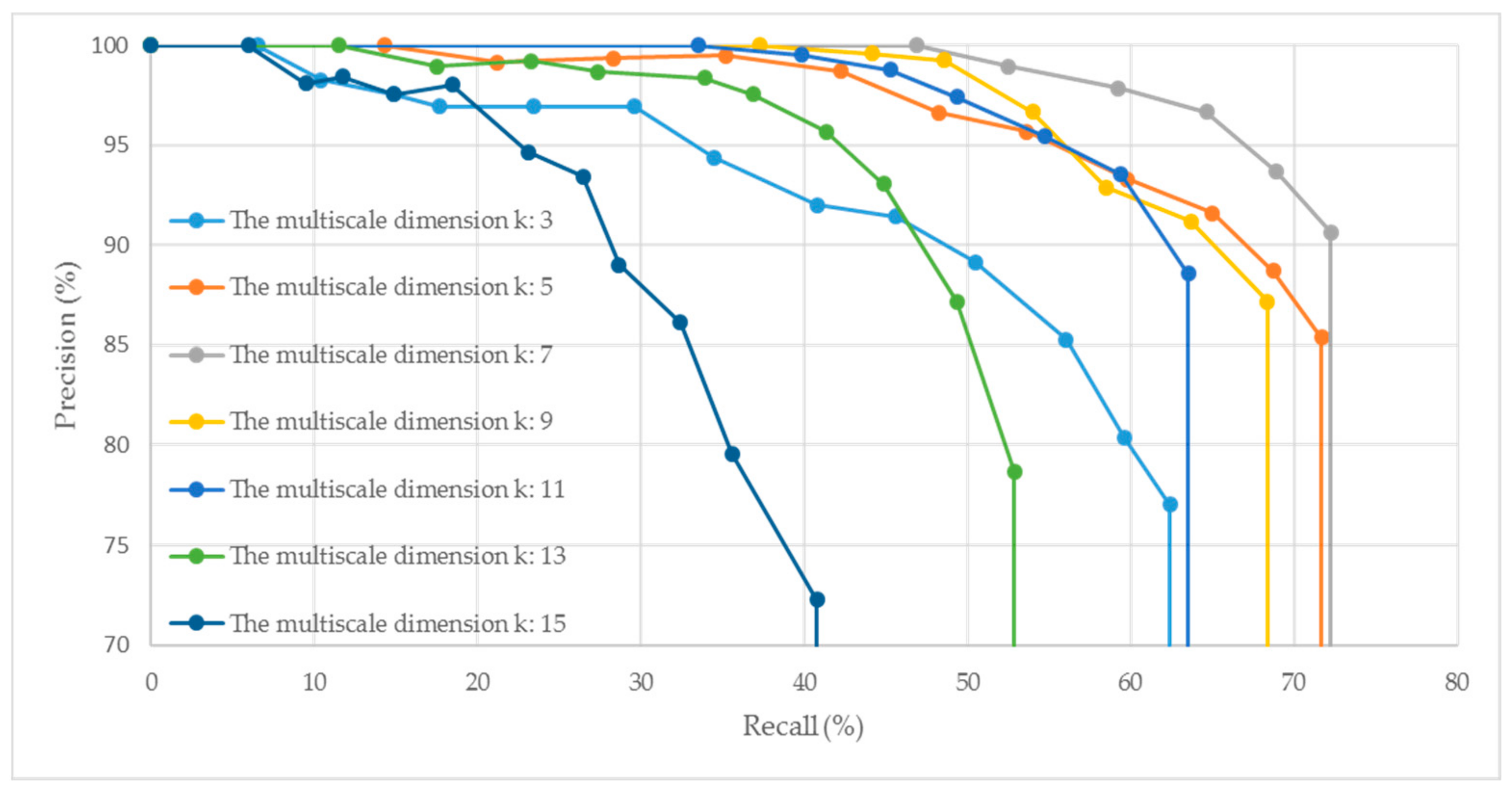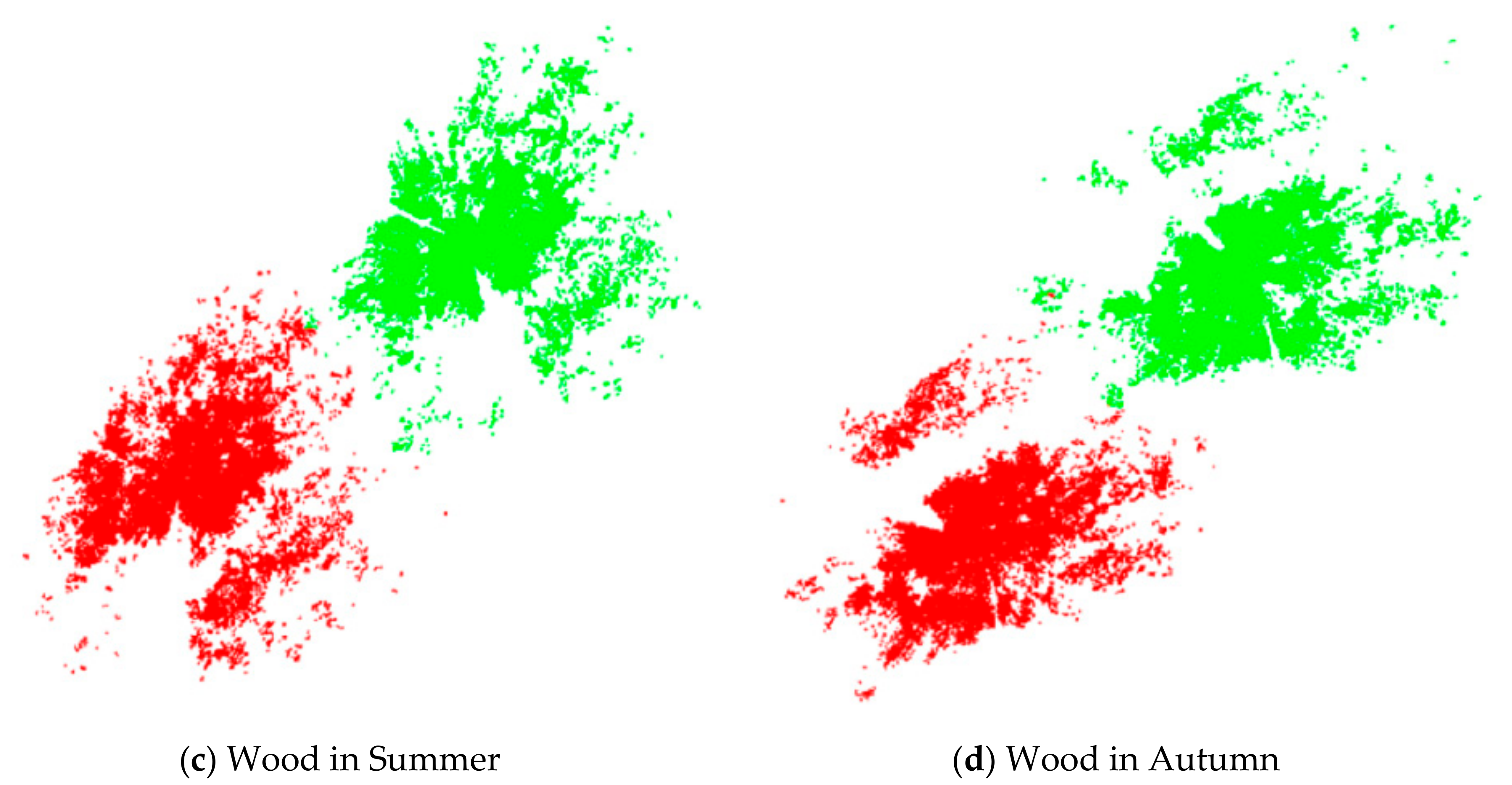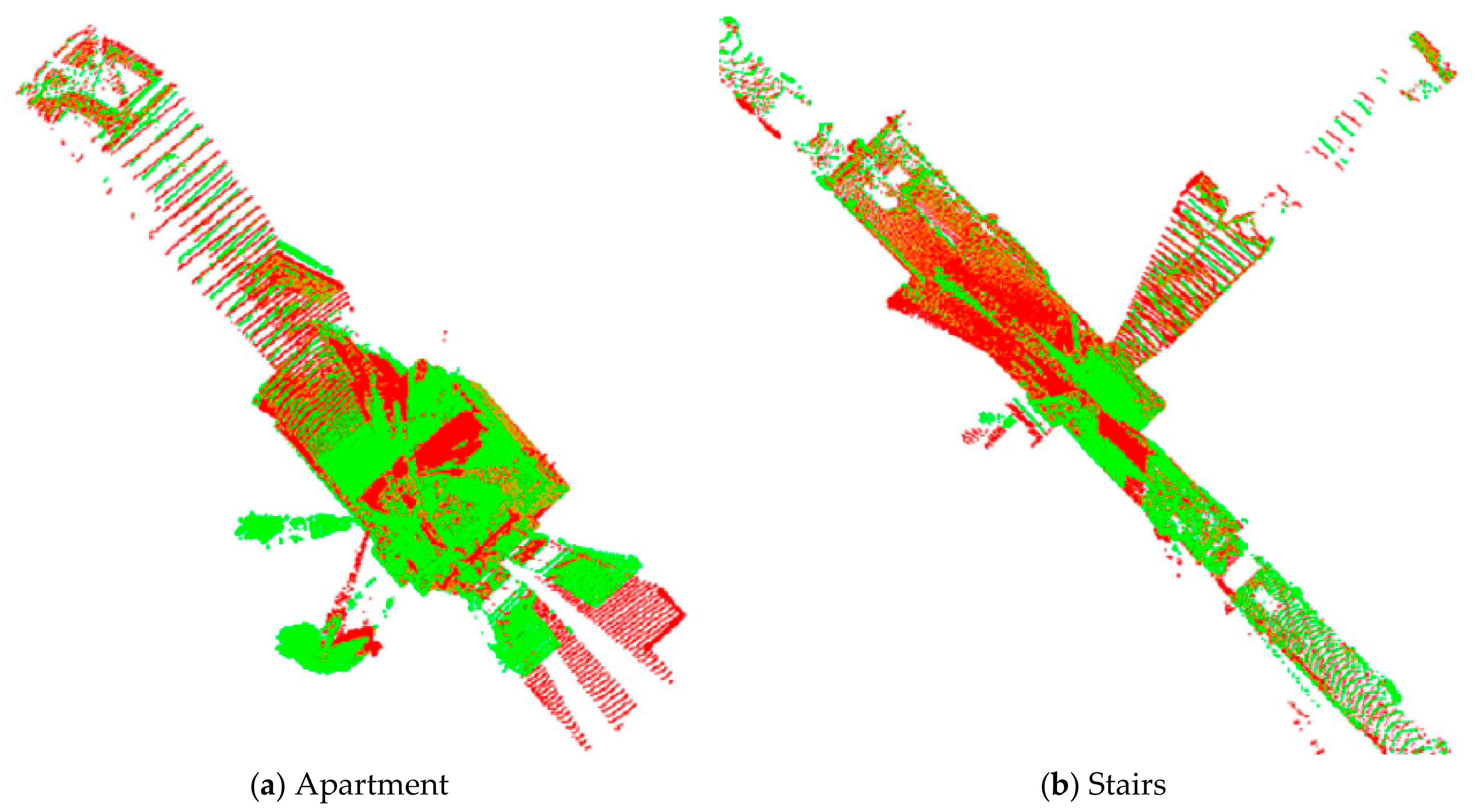Robust Coarse-to-Fine Registration Scheme for Mobile Laser Scanner Point Clouds Using Multiscale Eigenvalue Statistic-Based Descriptor †
Abstract
1. Introduction
- 1.
- A new 3D local descriptor with fewer dimensions (21 dimensions) was proposed to describe the keypoint under multiscale support radii.
- 2.
- The proposed descriptor was further used to identify the corresponding points from the different frames of MLS point clouds.
2. Multiscale Eigenvalues Statistic-Based Descriptor
2.1. Weight Assignment
2.2. Weighted Covariance Matrix
2.3. MEVS Descriptor
2.4. MEVS Generation Parameters
2.4.1. PR Curve Generation
- 1.
- A number of keypoints were detected from both the model and scene point clouds using the keypoint detector.
- 2.
- The proposed MEVS feature descriptor for each keypoint was computed using the proposed method.
- 3.
- The nearest neighbor distance ratio (NNDR) technique was used to match the feature descriptors.
2.4.2. Initial Support Radius
2.4.3. Multiscale Dimension
3. Coarse-to-Fine Pairwise Registration
3.1. Correspondences Estimation
3.2. Mismatches Rejection
3.3. Registration Calculation
4. Experiments and Analysis
4.1. Data Description
4.2. Evaluation Criteria
4.3. Results and Discussion
4.3.1. Keypoints Processing
4.3.2. Coarse-to-Fine Registration
5. Conclusions
Author Contributions
Funding
Institutional Review Board Statement
Informed Consent Statement
Data Availability Statement
Conflicts of Interest
References
- Gehrung, J.; Hebel, M.; Arens, M.; Stilla, U. A framework for voxel-based global scale modeling of urban environments. Int. Arch. Photogram. Remote Sens. Spat. Info Sci. 2016, 42, 45–51. [Google Scholar] [CrossRef]
- Serna, A.; Marcotegui, B. Urban accessibility diagnosis from mobile laser scanning data. ISPRS J. Photogramm. Remote Sens. 2013, 84, 23–32. [Google Scholar] [CrossRef]
- Yang, B.; Dong, Z.; Liu, Y.; Liang, F.; Wang, Y. Computing multiple aggregation levels and contextual features for road facilities recognition using mobile laser scanning data. ISPRS J. Photogramm. Remote Sens. 2017, 126, 180–194. [Google Scholar] [CrossRef]
- Kelbe, D.; Van, A.J.; Romanczyk, P.; Van, L.M.; Cawse-Nicholson, K. Marker-free registration of forest terrestrial laser scanner data pairs with embedded confidence metrics. IEEE Trans. Geosci. Remote Sens. 2016, 54, 4314–4330. [Google Scholar] [CrossRef]
- Polewski, P.; Yao, W.; Heurich, M.; Krzystek, P.; Stilla, U. Learning a constrained conditional random field for enhanced segmentation of fallen trees in ALS point clouds. ISPRS J. Photogramm. Remote Sens. 2018, 140, 33–44. [Google Scholar] [CrossRef]
- Prokop, A.; Panholzer, H. Assessing the capability of terrestrial laser scanning for monitoring slow moving landslides. Nat. Hazards Earth Syst. Sci. 2009, 9, 1921–1928. [Google Scholar] [CrossRef]
- Huang, R.; Ye, Z.; Boerner, R.; Yao, W.; Xu, Y.; Stilla, U. Fast pairwise coarse registration between point clouds of construction sites using 2D projection based phase correlation. Int. Arch. Photogram. Remote Sens. Spat. Info. Sci. 2019, XLII-2, 1015–1020. [Google Scholar] [CrossRef]
- Kukko, A.; Kaijaluoto, R.; Kaartinen, H.; Lehtola, V.; Jaakkola, A.; Hyyppä, J. Graph SLAM correction for single scanner MLS forest data under boreal forest canopy. ISPRS J. Photogramm. Remote Sens. 2017, 132, 199–209. [Google Scholar] [CrossRef]
- Liu, H.; Zhang, Y.; Lei, L.; Xie, H.; Li, Y.; Sun, S. Hierarchical Optimization of 3D Point Cloud Registration. Sensors 2020, 20, 6999. [Google Scholar] [CrossRef]
- Choi, O.; Park, M.-G.; Hwang, Y. Iterative K-Closest Point Algorithms for Colored Point Cloud Registration. Sensors 2020, 20, 5331. [Google Scholar] [CrossRef]
- Li, P.; Wang, R.; Wang, Y.; Gao, G. Fast Method of Registration for 3D RGB Point Cloud with Improved Four Initial Point Pairs Algorithm. Sensors 2020, 20, 138. [Google Scholar] [CrossRef]
- Guo, Y.; Sohel, F.; Bennamoun, M.; Lu, M.; Wan, J. Rotational projection statistics for 3D local surface description and object recognition. Int. J. Comput. Vision. 2013, 105, 63–86. [Google Scholar] [CrossRef]
- Dong, Z.; Liang, F.; Yang, B.; Xu, Y.; Zang, Y.; Li, J.; Wang, Y.; Dai, W.; Fan, H.; Hyyppä, J.; et al. Registration of large-scale terrestrial laser scanner point clouds: A review and benchmark. ISPRS J. Photogramm. Remote Sens. 2020, 163, 327–342. [Google Scholar] [CrossRef]
- Besl, P.J.; McKay, N.D. A method for registration of 3-D shapes. IEEE Trans. Pattern Anal. Mach. Intell. 1992, 14, 239–256. [Google Scholar] [CrossRef]
- Ren, Z.; Wang, L.; Bi, L. Robust GICP-based 3D LiDAR SLAM for underground mining environment. Sensors 2019, 19, 2915. [Google Scholar] [CrossRef] [PubMed]
- Tazir, M.L.; Gokhool, T.; Checchin, P.; Malaterre, L.; Trassoudaine, L. Cluster ICP: Towards Sparse to Dense Registration. In Proceedings of the 15th International Conference on Intelligent Autonomous Systems, Baden-Baden, Germany, 11–15 June 2018; pp. 730–747. [Google Scholar]
- Takeuchi, E.; Tsubouchi, T. A 3-D scan matching using improved 3-D normal distributions transform for mobile robotic mapping. In Proceedings of the IEEE/RSJ International Conference on Intelligent Robots and Systems, Beijing, China, 9–15 October 2006; pp. 3068–3073. [Google Scholar]
- Das, A.; Waslander, S.L. Scan registration with multi-scale k-means normal distributions transform. In Proceedings of the IEEE/RSJ International Conference on Intelligent Robots and Systems, Vilamoura, Portugal, 7–12 October 2012; pp. 2705–2710. [Google Scholar]
- Das, A.; Waslander, S.L. Scan registration using segmented region growing NDT. Int. J. Robot. Res. 2014, 33, 1645–1663. [Google Scholar] [CrossRef]
- Fischler, M.; Bolles, R. Random sample consensus: A paradigm for model fitting with applications to image analysis and automated cartography. Commun. ACM 1987, 24, 381–395. [Google Scholar] [CrossRef]
- Frome, A.; Huber, D.; Kolluri, R.; Bülow, T.; Malik, J. Recognizing objects in range data using regional point descriptors. In Proceedings of the 8th European Conference on Computer Vision, Prague, Czech Republic, 11–14 May 2004; pp. 224–237. [Google Scholar]
- Rusu, B.; Blodow, N.; Marton, Z.; Beetz, M. Aligning point cloud views using persistent feature histograms. In Proceedings of the IEEE/RSJ International Conference on Intelligent Robots and Systems, Nice, France, 22–26 September 2008; pp. 3384–3391. [Google Scholar]
- Rusu, R.; Nico, B.; Beetz, M. Fast point feature histograms (FPFH) for 3D registration. In Proceedings of the IEEE International Conference on Robotics and Automation, Kobe, Japan, 12–17 May 2009; pp. 3212–3217. [Google Scholar]
- Salti, S.; Tombari, F.; Stefano, L. SHOT: Unique signatures of histograms for surface and texture description. Comput. Vis. Image Underst. 2014, 125, 251–264. [Google Scholar] [CrossRef]
- Dong, Z.; Yang, B.; Liu, Y.; Liang, F.; Li, B.; Zang, Y. A novel binary shape context for 3D local surface description. ISPRS J. Photogramm. Remote Sens. 2017, 130, 431–452. [Google Scholar] [CrossRef]
- Li, W.; Wang, C.; Wen, C.; Zhang, Z.; Lin, C.; Li, J. Pairwise registration of TLS point clouds by deep multi-scale local features. Neurocomputing 2020, 386, 232–243. [Google Scholar] [CrossRef]
- Khazari, A.E.; Que, Y.; Sung, T.L.; Lee, H.J. Deep global features for point cloud alignment. Sensors 2020, 20, 4032. [Google Scholar] [CrossRef]
- Aiger, D.; Mitra, N.; Cohen-Or, D. Four-points congruent sets for robust surface registration. ACM Trans. Graph. 2008, 27, 1–10. [Google Scholar] [CrossRef]
- Mellado, N.; Aiger, D.; Mitra, N. Super 4PCS fast global point cloud registration via smart indexing. Comput. Graph. Forum. 2014, 3, 205–215. [Google Scholar] [CrossRef]
- Huang, J.; Kwok, T.-H.; Zhou, C. V4PCS: Volumetric 4PCS algorithm for global registration. J. Mech. Des. 2017, 139, 1–9. [Google Scholar] [CrossRef]
- Xu, Y.; Boerner, R.; Yao, W.; Hoegner, L.; Stilla, U. Pairwise coarse registration of point clouds in urban scenes using voxel-based 4-planes congruent sets. ISPRS J. Photogramm. Remote Sens. 2019, 151, 106–123. [Google Scholar] [CrossRef]
- Myronenko, A.; Song, X.; Carreira-Perpiñán, M.A. Non-rigid point set registration: Coherent point drift. In Proceedings of the Advances in Neural Information Processing Systems, Vancouver, BC, Canada, 4–7 December 2006; pp. 1009–1016. [Google Scholar]
- Golyanik, V.; Taetz, B.; Reis, G.; Stricker, D. Extended coherent point drift algorithm with correspondence priors and optimal subsampling. In Proceedings of the IEEE Winter Conference on Applications of Computer Vision (WACV), Lake Placid, NY, USA, 7–10 March 2016; pp. 1–9. [Google Scholar]
- Zang, Y.; Lindenbergh, R. An improved coherent point drift method for TLS point cloud registration of complex scenes. Int. Arch. Photogram. Remote Sens. Spat. Info. Sci. 2019, W13, 1169–1175. [Google Scholar] [CrossRef]
- Guo, Y.; Bennamoun, M.; Sohel, F.; Lu, M.; Wan, J.; Kwok, N. A comprehensive performance evaluation of 3D local feature descriptors. Int. J. Comput. Vis. 2016, 116, 66–89. [Google Scholar] [CrossRef]
- Lowe, D.G. Distinctive image features from scale-invariant keypoints. Int. J. Comput. Vis. 2004, 60, 91–110. [Google Scholar] [CrossRef]
- Lo, T.; Siebert, J. Local feature extraction and matching on range images: 2.5D SIFT. Comput. Vis. Image Underst. 2009, 113, 1235–1250. [Google Scholar] [CrossRef]
- Sipiran, I.; Bustos, B. Harris 3D: A robust extension of the Harris operator for interest point detection on 3D meshes. Vis. Comput. 2011, 27, 963–976. [Google Scholar] [CrossRef]
- Steder, B.; Rusu, R.B.; Konolige, K.; Burgard, W. Point feature extraction on 3D range scans taking into account object boundaries. In Proceedings of the IEEE International Conference on Robotics and Automation (ICRA), Shanghai, China, 9–13 May 2011; pp. 2601–2608. [Google Scholar]
- Zhong, Y. Intrinsic shape signatures: A shape descriptor for 3D object recognition. In Proceedings of the IEEE 12th International Conference on Computer Vision Workshops, Kyoto, Japan, 27 September–4 October 2009; pp. 689–696. [Google Scholar]
- Zhou, R.; Li, X.; Jiang, W. 3D surface matching by a voxel-based buffer-weighted binary descriptor. IEEE Access 2020, 7, 86635–86650. [Google Scholar] [CrossRef]
- Yang, B.; Dong, Z.; Liang, F.; Liu, Y. Automatic registration of large-scale urban scene point clouds based on semantic feature points. ISPRS J. Photogramm. Remote Sens. 2016, 113, 43–58. [Google Scholar] [CrossRef]
- Chen, H.; Bhanu, B. 3D free-form object recognition in range images using local surface patches. Pattern Recognit. Lett. 2007, 28, 1252–1262. [Google Scholar] [CrossRef]
- Theiler, P.; Wegner, J.; Schindler, K. Globally consistent registration of terrestrial laser scans via graph optimization. ISPRS J. Photogramm. Remote Sens. 2015, 109, 126–138. [Google Scholar] [CrossRef]
- Pomerleau, F.; Liu, M.; Colas, F.; Siegwart, R. Challenging data sets for point cloud registration algorithms. Int. J. Robot. Res. 2012, 31, 1705–1711. [Google Scholar] [CrossRef]
- Dong, Z.; Yang, B.; Liang, F.; Huang, R.; Scherer, S. Hierarchical registration of unordered TLS point clouds based on binary shape context descriptor. ISPRS J. Photogramm. Remote Sens. 2018, 144, 61–79. [Google Scholar] [CrossRef]
- Petricek, T.; Svoboda, T. Point cloud registration from local feature correspondences—Evaluation on challenging datasets. PLoS ONE 2017, 12, e0187943. [Google Scholar] [CrossRef]











| R = 5 mr | R = 8 mr | R = 10 mr | R = 12 mr | R = 15 mr | |
| k = 3 | 0.516 | 0.587 | 0.583 | 0.583 | 0.560 |
| k = 5 | 0.632 | 0.726 | 0.696 | 0.758 | 0.685 |
| k = 7 | 0.714 | 0.738 | 0.714 | 0.778 | 0.630 |
| k = 9 | 0.736 | 0.750 | 0.670 | 0.762 | 0.599 |
| k = 11 | 0.776 | 0.723 | 0.625 | 0.701 | 0.449 |
| k = 13 | 0.765 | 0.691 | 0.512 | 0.692 | 0.288 |
| k = 15 | 0.756 | 0.660 | 0.377 | 0.637 | 0.156 |
| Ground-Truth | Apartment | Stairs | Wood in Summer | Wood in Autumn | ||||||||
| Rotation matrix | 0.9931 | −0.1164 | 0.0058 | 0.9883 | 0.1524 | 0.0043 | 0.9843 | −0.1727 | −0.0361 | 0.9895 | −0.1438 | −0.1438 |
| 0.1164 | 0.9931 | 0.0034 | −0.1522 | 0.9878 | −0.0301 | 0.1726 | 0.9849 | −0.0035 | 0.1440 | 0.9891 | −0.0280 | |
| −0.0062 | −0.0027 | 0.9999 | −0.0088 | 0.0291 | 0.9995 | 0.0362 | −0.0027 | 0.9993 | −0.0049 | 0.0290 | 0.9995 | |
| Translation vector | 0.6148 | −0.0142 | 0.0085 | 0.4232 | −0.0508 | 0.0670 | 0.6057 | 0.0407 | 0.0269 | 0.4946 | 0.0496 | 0.0150 |
| Datasets | Frames | Mean Point Number | Scene | Spatial Scale (m) | Dynamics |
| Apartment | 45 | 365,000 | Indoors | 17 × 10 × 3 | Furniture moved between scans |
| Stairs | 31 | 191,000 | Mixed | 21 × 111 × 27 | Non |
| Wood in Summer | 37 | 182,000 | Outdoors | 30 × 53 × 20 | Seasonal changes |
| Wood in Autumn | 32 | 178,000 | Outdoors | 36 × 60 × 22 | Seasonal changes |
| Datasets | Original Points’ Number | Keypoints’ Number | Matching Keypoints’ Number |
| Apartment | 370,260/370,277 | 9140/10,436 | 3102 |
| Stairs | 185,850/181,077 | 6829/7067 | 2280 |
| Wood in Summer | 192,802/183,179 | 4556/4721 | 1746 |
| Wood in Autumn | 190,499/189,441 | 4811/5130 | 1914 |
| Datasets | Methods | Coarse Registration | Fine Registration | ||
| Rotation Error (rad) | Translation Error (m) | Rotation Error (rad) | Translation Error (m) | ||
| Apartment | Method1 | 0.0789 | 0.336 | 0.0530 | 0.165 |
| Method2 | 0.8244 | 1.094 | 0.2377 | 0.601 | |
| Method3 | 0.2336 | 0.365 | 0.0399 | 0.071 | |
| Our method | 0.0483 | 0.145 | 0.0316 | 0.078 | |
| Stairs | Method1 | 0.0503 | 0.139 | 0.0491 | 0.139 |
| Method2 | 0.2246 | 0.726 | 0.0612 | 0.150 | |
| Method3 | 0.0602 | 0.122 | 0.0214 | 0.149 | |
| Our method | 0.0124 | 0.084 | 0.0090 | 0.023 | |
| Wood in Summer | Method1 | 0.0592 | 0.330 | 0.0278 | 0.092 |
| Method2 | 0.2476 | 1.225 | 0.0957 | 0.640 | |
| Method3 | 0.2559 | 0.296 | 0.0238 | 0.109 | |
| Our method | 0.0682 | 0.132 | 0.0220 | 0.039 | |
| Wood in Autumn | Method1 | 0.0634 | 0.304 | 0.0503 | 0.240 |
| Method2 | 0.1861 | 0.545 | 0.0280 | 0.050 | |
| Method3 | 0.3118 | 0.505 | 0.0511 | 0.209 | |
| Our method | 0.0503 | 0.240 | 0.0125 | 0.078 | |
| Datasets | Methods | Coarse Registration Time (min) | Fine Registration | Total Time (min) | |
| Time (min) | Iterations | ||||
| Apartment | Method1 | 0.10 | 17.71 | 17 | 17.81 |
| Method2 | 6.51 | 35.05 | 31 | 41.56 | |
| Method3 | 0.12 | 29.68 | 26 | 29.80 | |
| Our method | 0.26 | 15.25 | 15 | 15.21 | |
| Stairs | Method1 | 0.05 | 6.39 | 14 | 6.44 |
| Method2 | 4.85 | 7.62 | 17 | 12.47 | |
| Method3 | 0.06 | 3.51 | 10 | 3.57 | |
| Our method | 0.95 | 2.04 | 5 | 2.99 | |
| Wood in Summer | Method1 | 0.04 | 4.21 | 14 | 4.25 |
| Method2 | 2.88 | 9.95 | 33 | 12.83 | |
| Method3 | 0.06 | 9.92 | 33 | 9.98 | |
| Our method | 0.08 | 3.72 | 13 | 3.80 | |
| Wood in Autumn | Method1 | 0.04 | 5.02 | 15 | 5.06 |
| Method2 | 2.10 | 16.04 | 48 | 18.14 | |
| Method3 | 0.05 | 8.49 | 24 | 8.54 | |
| Our method | 0.10 | 3.73 | 11 | 3.83 | |
Publisher’s Note: MDPI stays neutral with regard to jurisdictional claims in published maps and institutional affiliations. |
© 2021 by the authors. Licensee MDPI, Basel, Switzerland. This article is an open access article distributed under the terms and conditions of the Creative Commons Attribution (CC BY) license (https://creativecommons.org/licenses/by/4.0/).
Share and Cite
Fu, Y.; Li, Z.; Wang, W.; He, H.; Xiong, F.; Deng, Y. Robust Coarse-to-Fine Registration Scheme for Mobile Laser Scanner Point Clouds Using Multiscale Eigenvalue Statistic-Based Descriptor. Sensors 2021, 21, 2431. https://doi.org/10.3390/s21072431
Fu Y, Li Z, Wang W, He H, Xiong F, Deng Y. Robust Coarse-to-Fine Registration Scheme for Mobile Laser Scanner Point Clouds Using Multiscale Eigenvalue Statistic-Based Descriptor. Sensors. 2021; 21(7):2431. https://doi.org/10.3390/s21072431
Chicago/Turabian StyleFu, Yongjian, Zongchun Li, Wenqi Wang, Hua He, Feng Xiong, and Yong Deng. 2021. "Robust Coarse-to-Fine Registration Scheme for Mobile Laser Scanner Point Clouds Using Multiscale Eigenvalue Statistic-Based Descriptor" Sensors 21, no. 7: 2431. https://doi.org/10.3390/s21072431
APA StyleFu, Y., Li, Z., Wang, W., He, H., Xiong, F., & Deng, Y. (2021). Robust Coarse-to-Fine Registration Scheme for Mobile Laser Scanner Point Clouds Using Multiscale Eigenvalue Statistic-Based Descriptor. Sensors, 21(7), 2431. https://doi.org/10.3390/s21072431







